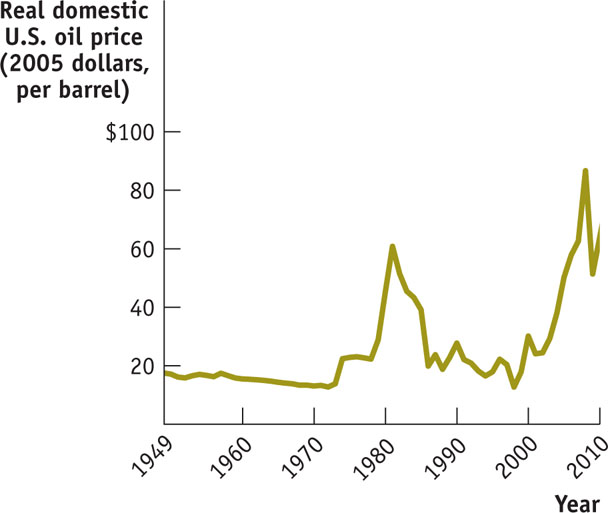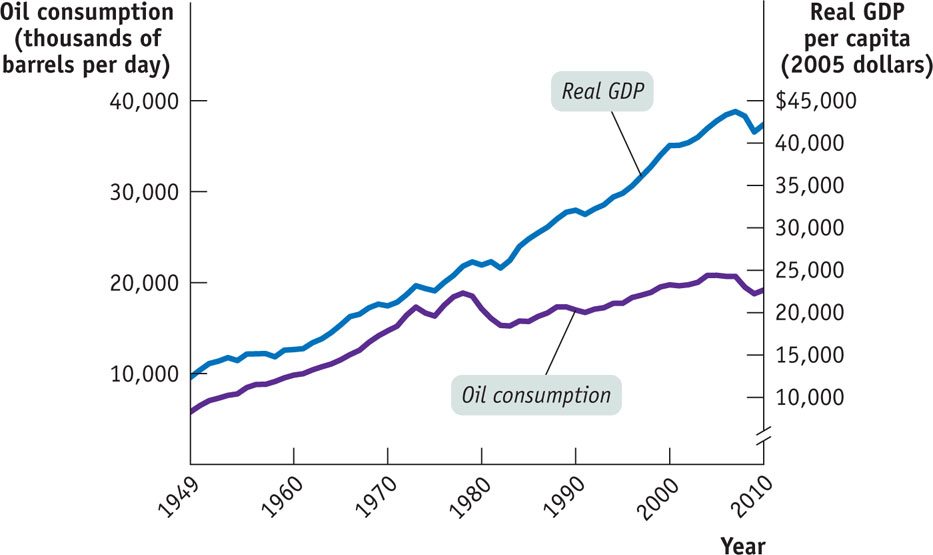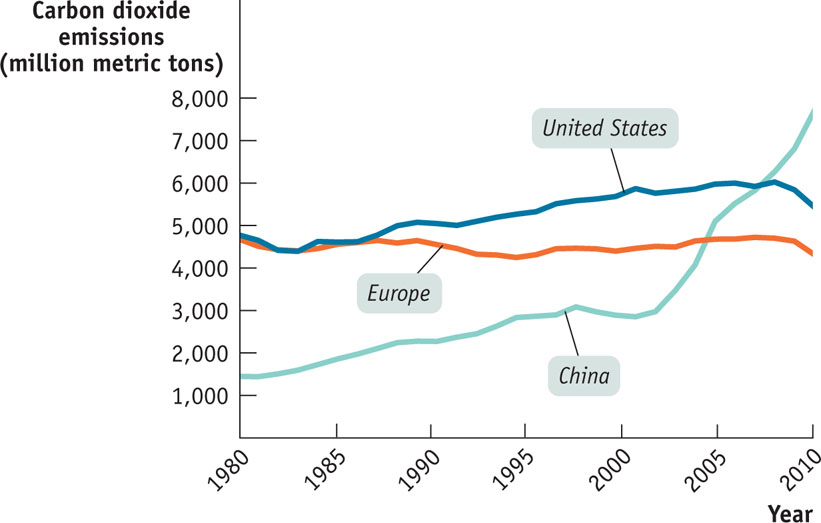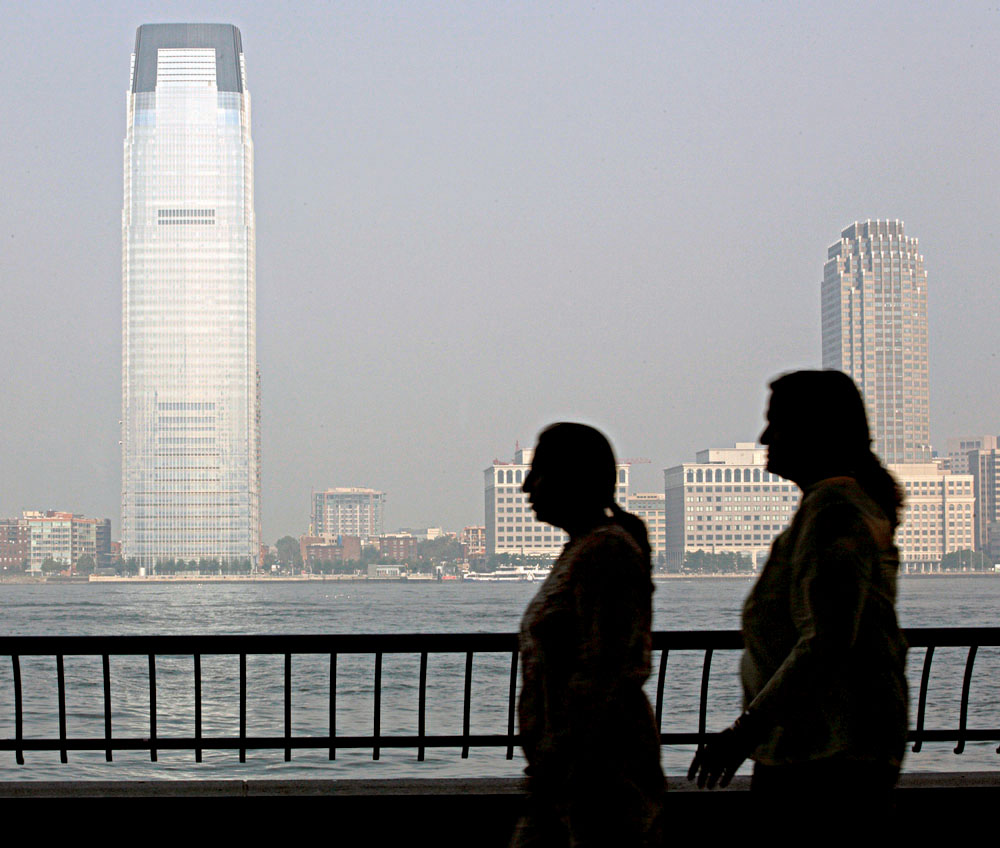Is World Growth Sustainable?
Earlier in this chapter we described the views of Thomas Malthus, the early-nineteenth-century economist who warned that the pressure of population growth would tend to limit the standard of living. Malthus was right about the past: for around 58 centuries, from the origins of civilization until his own time, limited land supplies effectively prevented any large rise in real incomes per capita. Since then, however, technological progress and rapid accumulation of physical and human capital have allowed the world to defy Malthusian pessimism.
Sustainable long-run economic growth is long-run growth that can continue in the face of the limited supply of natural resources and the impact of growth on the environment.
But will this always be the case? Some skeptics have expressed doubt about whether sustainable long-run economic growth is possible—whether it can continue in the face of the limited supply of natural resources and the impact of growth on the environment.
Natural Resources and Growth, Revisited
In 1972 a group of scientists called The Club of Rome made a big splash with a book titled The Limits to Growth, which argued that long-run economic growth wasn’t sustainable due to limited supplies of nonrenewable resources such as oil and natural gas. These “neo-Malthusian” concerns at first seemed to be validated by a sharp rise in resource prices in the 1970s, then came to seem foolish when resource prices fell sharply in the 1980s. After 2005, however, resource prices rose sharply again, leading to renewed concern about resource limitations to growth. Figure 13-10 shows the real price of oil—the price of oil adjusted for inflation in the rest of the economy. The rise, fall, and rise of concern about resource-based limits to growth have more or less followed the rise, fall, and rise of oil prices shown in the figure.
FIGURE 13-10 The Real Price of Oil, 1949–2010

Differing views about the impact of limited natural resources on long-run economic growth turn on the answers to three questions:
- How large are the supplies of key natural resources?
- How effective will technology be at finding alternatives to natural resources?
- Can long-run economic growth continue in the face of resource scarcity?
It’s mainly up to geologists to answer the first question. Unfortunately, there’s wide disagreement among the experts, especially about the prospects for future oil production. Some analysts believe that there is enough untapped oil in the ground that world oil production can continue to rise for several decades. Others, including a number of oil company executives, believe that the growing difficulty of finding new oil fields will cause oil production to plateau—that is, stop growing and eventually begin a gradual decline—in the fairly near future. Some analysts believe that we have already reached that plateau.
The answer to the second question, whether there are alternatives to natural resources, has to come from engineers. There’s no question that there are many alternatives to the natural resources currently being depleted, some of which are already being exploited. For example, “unconventional” oil extracted from Canadian tar sands is already making a significant contribution to world oil supplies, and electricity generated by wind turbines is rapidly becoming big business.
The third question, whether economies can continue to grow in the face of resource scarcity, is mainly a question for economists. And most, though not all, economists are optimistic: they believe that modern economies can find ways to work around limits on the supply of natural resources. One reason for this optimism is the fact that resource scarcity leads to high resource prices. These high prices in turn provide strong incentives to conserve the scarce resource and to find alternatives.
For example, after the sharp oil price increases of the 1970s, American consumers turned to smaller, more fuel-efficient cars, and U.S. industry also greatly intensified its efforts to reduce energy bills. The result is shown in Figure 13-11, which compares U.S. real GDP per capita and oil consumption before and after the 1970s energy crisis. In the United States before 1973, there seemed to be a more or less one-to-one relationship between economic growth and oil consumption. But after 1973 the U.S. economy continued to deliver growth in real GDP per capita even as it substantially reduced the use of oil. This move toward conservation paused after 1990, as low real oil prices encouraged consumers to shift back to gas-greedy larger cars and SUVs. But a sharp rise in oil prices from 2005 to 2008, and again in 2010, encouraged renewed shifts toward oil conservation.
FIGURE 13-11 U.S. Oil Consumption and Growth over Time

Given such responses to prices, economists generally tend to see resource scarcity as a problem that modern economies handle fairly well, and so not a fundamental limit to long-run economic growth. Environmental issues, however, pose a more difficult problem because dealing with them requires effective political action.
Economic Growth and the Environment
Economic growth, other things equal, tends to increase the human impact on the environment. For example, China’s spectacular economic growth has also brought a spectacular increase in air pollution in that nation’s cities.
It’s important to realize, however, that other things aren’t necessarily equal: countries can and do take action to protect their environments. In fact, air and water quality in today’s advanced countries is generally much better than it was a few decades ago. London’s famous “fog”—actually a form of air pollution, which killed 4,000 people during a two-week episode in 1952—is gone, thanks to regulations that virtually eliminated the use of coal heat. The equally famous smog of Los Angeles, although not extinguished, is far less severe than it was in the 1960s and early 1970s, again thanks to pollution regulations.
Despite these past environmental success stories, there is widespread concern today about the environmental impacts of continuing economic growth, reflecting a change in the scale of the problem. Environmental success stories have mainly involved dealing with local impacts of economic growth, such as the effect of widespread car ownership on air quality in the Los Angeles basin. Today, however, we are faced with global environmental issues—the adverse impacts on the environment of the Earth as a whole by worldwide economic growth. The biggest of these issues involves the impact of fossil-fuel consumption on the world’s climate.
Burning coal and oil releases carbon dioxide into the atmosphere. There is broad scientific consensus that rising levels of carbon dioxide and other gases are causing a greenhouse effect on the Earth, trapping more of the sun’s energy and raising the planet’s overall temperature. And rising temperatures may impose high human and economic costs: rising sea levels may flood coastal areas; changing climate may disrupt agriculture, especially in poor countries; and so on.
The problem of climate change is clearly linked to economic growth. Figure 13-12 shows carbon dioxide emissions from the United States, Europe, and China since 1980. Historically, the wealthy nations have been responsible for the bulk of these emissions because they have consumed far more energy per person than poorer countries. As China and other emerging economies have grown, however, they have begun to consume much more energy and emit much more carbon dioxide.
FIGURE 13-12 Climate Change and Growth

Is it possible to continue long-run economic growth while curbing the emissions of greenhouse gases? The answer, according to most economists who have studied the issue, is yes. It should be possible to reduce greenhouse gas emissions in a wide variety of ways, ranging from the use of non-fossil-fuel energy sources such as wind, solar, and nuclear power; to preventive measures such as carbon sequestration (capturing the carbon dioxide from power plants and storing it); to simpler things like designing buildings so that they’re easier to keep warm in winter and cool in summer. Such measures would impose costs on the economy, but the best available estimates suggest that even a large reduction in greenhouse gas emissions over the next few decades would only modestly dent the long-term rise in real GDP per capita.
The problem is how to make all of this happen. Unlike resource scarcity, environmental problems don’t automatically provide incentives for changed behavior. Pollution is an example of a negative externality, a cost that individuals or firms impose on others without having to offer compensation. In the absence of government intervention, individuals and firms have no incentive to reduce negative externalities, which is why it took regulation to reduce air pollution in America’s cities. And as Nicholas Stern, the author of an influential report on climate change, put it, greenhouse gas emissions are “the mother of all externalities.”
So there is a broad consensus among economists—although there are some dissenters—that government action is needed to deal with climate change. There is also broad consensus that this action should take the form of market-based incentives, either in the form of a carbon tax—a tax per unit of carbon emitted—or a cap and trade system in which the total amount of emissions is capped, and producers must buy licenses to emit greenhouse gases. There is, however, considerable dispute about how much action is appropriate, reflecting both uncertainty about the costs and benefits and scientific uncertainty about the pace and extent of climate change.
There are also several aspects of the climate change problem that make it much more difficult to deal with than, say, smog in Los Angeles. One is the problem of taking the long view. The impact of greenhouse gas emissions on the climate is very gradual: carbon dioxide put into the atmosphere today won’t have its full effect on the climate for several generations. As a result, there is the political problem of persuading voters to accept pain today in return for gains that will benefit their children, grandchildren, or even great-grandchildren.
There is also a difficult problem of international burden sharing. As Figure 13-12 shows, today’s rich economies have historically been responsible for most greenhouse gas emissions, but newly emerging economies like China are responsible for most of the recent growth. Inevitably, rich countries are reluctant to pay the price of reducing emissions only to have their efforts frustrated by rapidly growing emissions from new players. On the other hand, countries like China, which are still relatively poor, consider it unfair that they should be expected to bear the burden of protecting an environment threatened by the past actions of rich nations.
The general moral of this story is that it is possible to reconcile long-run economic growth with environmental protection. The main question is one of getting political consensus around the necessary policies.
The Cost of Climate Protection

In recent years a number of bills have been introduced before the U.S. Congress, some of them with bipartisan sponsorship, calling for ambitious, long-term efforts to reduce U.S. emissions of greenhouse gases. For example, a bill sponsored by Senators Joseph Lieberman and John McCain would have used a cap and trade system to gradually reduce emissions over time, eventually—by 2050—reducing them to 60% below their 1990 level. Another bill, sponsored by Senators Barbara Boxer and Bernie Sanders, called for an 80% reduction by 2050.
Would implementing these bills, or others like them, put a stop to long-run economic growth? Not according to a comprehensive study by a team at MIT, which found that reducing emissions would impose significant but not overwhelming costs. Using an elaborate model of the interaction between environmental policy and the economy, the MIT group estimated that the Lieberman–McCain proposal would reduce real GDP per capita in 2050 by 1.11% and the more stringent Sanders–Boxer proposal would reduce real GDP per capita by 1.79%.
These may sound like big numbers—they would amount to between $200 billion and $250 billion today—but they would hardly make a dent in the economy’s long-run growth rate. Remember that over the long run the U.S. economy has on average seen real GDP per capita rise by almost 2% a year. If the MIT group’s estimates are correct, even a strong policy to avert climate change would, in effect, require that we give up less than one year’s growth over the next four decades.
Quick Review
- There’s wide disagreement about whether it is possible to have sustainable long-run economic growth. However, economists generally believe that modern economies can find ways to alleviate limits to growth from natural resource scarcity through the price response that promotes conservation and the creation of alternatives.
- Overcoming the limits to growth arising from environmental degradation is more difficult because it requires effective government intervention. Limiting the emission of greenhouse gases would require only a modest reduction in the growth rate.
- There is broad consensus that government action to address climate change and greenhouse gases should be in the form of market-based incentives, like a carbon tax or a cap and trade system. It will also require rich and poor countries to come to some agreement on how the cost of emissions reductions will be shared.
Check Your Understanding 13-5
Question
Are economists typically more concerned about the limits to growth imposed by environmental degradation or those imposed by resource scarcity?
A. B. Economists are typically more concerned about environmental degradation than resource scarcity. The reason is that in modern economies the price response tends to alleviate the limits imposed by resource scarcity through conservation and the development of alternatives. However, because environmental degradation involves a negative externality (a cost imposed by individuals or firms on others without the requirement to pay compensation) effective government intervention is required to address it. As a result, economists are more concerned about the limits to growth imposed by environmental degradation because a market response would be inadequate.Question
Which of the following explains the link between greenhouse gas emissions and growth?
A. B. C. D. Growth increases a country's greenhouse gas emissions. The current best estimates are that a large reduction in emissions will result in only a modest reduction in growth. The international burden sharing of greenhouse gas emissions reduction is contentious because rich countries are reluctant to pay the costs of reducing their emissions only to see newly emerging countries like China rapidly increase their emissions. Yet most of the current accumulation of gases is due to the past actions of rich countries. Poorer countries like China are equally reluctant to sacrifice their growth to pay for the past actions of rich countries.
Solutions appear at back of book.